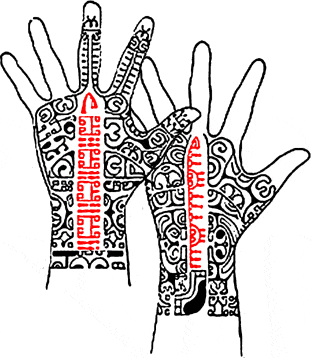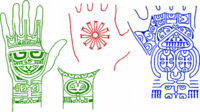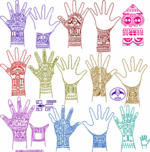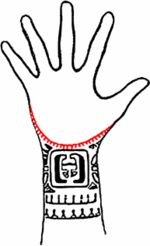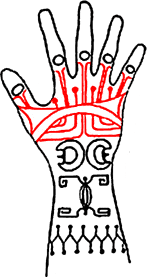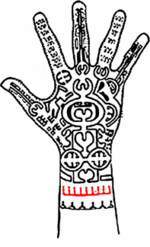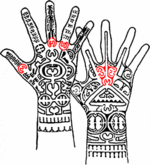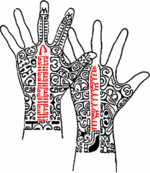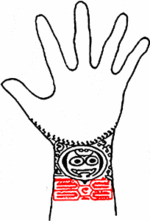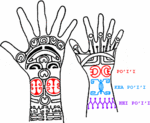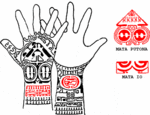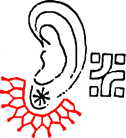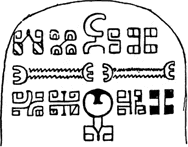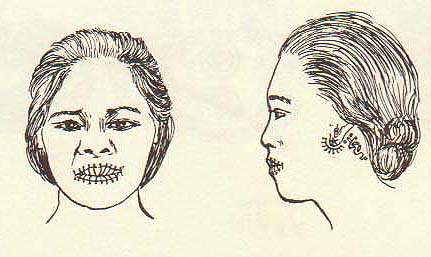Kava and Kea: Difference between pages
(Page conversion via llm-mediawiki-rev -jwm) |
(Page conversion via llm-mediawiki-rev -jwm) |
||
| Line 1: | Line 1: | ||
[[File: | [[File:Ka%27ava-1.gif|right|thumb|311px]] | ||
''' | '''The Marquesas Islands''' are an island group in French Polynesia. The islands are approximately 1,000 miles (1,600 km) northeast of [[Tahiti]], and were first settled almost 2000 years ago by the Polynesians. | ||
The islands deserve a mention here as the '''Marquesan tattoo'''ing tradition has had a great influence on today's artists. | |||
== Contents == | == Contents == | ||
# [[#Marquesan_Tattoo_Tradition|Marquesan Tattoo Tradition]] | |||
# [[#Hand_Tattoos|Hand Tattoos]] | |||
# [[#Marquesan_Motifs|Marquesan Motifs]] | |||
# [[#Ear_Tattooing|Ear Tattooing]] | |||
# [[#Other_Tattoo_Traditions|Other Tattoo Traditions]] | |||
# [[#Related_Articles|Related Articles]] | |||
# [[#External_Links|External Links]] | |||
== | ==Marquesan Tattoo Tradition== | ||
Boys received their first tattoos in their teens in a ritual setting, and by old age often had tattoos all over their bodies. Women were also tattooed, but nowhere near as extensively as the men. | |||
The designs share many symbolic motifs, but were never copied entirely; every individual's tattoos were different and signified his position in the family. | |||
The sailors on board the ships of Captain [[James Cook]] and other explorers from the West brought tattooing back with them, influenced by the designs they had seen on the inhabitants of these islands. These early tattoos, on the bodies of sailors, began the reintroduction of tattooing to the West. | |||
While tattooing is still performed on the Marquesas Islands, the images no longer carry their former significance, and are generally done with a [[Tattoo Machine]] rather than by the traditional method. | |||
== | ==Hand Tattoos== | ||
'''Hand tattooing''' is an important part of Marquesan tattooing, containing both specific iconography and individualized application. While some designs are male or female oriented, there is some interchange between the two. | |||
{| class="wikitable" style="text-align: center" | |||
|- | |||
! [[File:Marquesan_hand_tattoo-1.gif|200px|thumb|none|Male hand tattoos]] | |||
! [[File:Marquesan_hand_tattoo-2.gif|150px|thumb|none|Female hand tattoos.]] | |||
|} | |||
The following are | ==Marquesan Motifs== | ||
The following are a few examples on hands of '''Marquesan tattoo motifs'''. | |||
=== | {| class="wikitable" style="text-align: center" | ||
'' | |- | ||
! colspan="3" | | |||
|- | |||
! [[File:Fanaua-1.gif|150px|thumb|none|''Fanaua'' is a kind of evil spirit]] | |||
! [[File:Nutu_Kaha-1.gif|147px|thumb|none|''Nutu Kaha'' symbolizes a mouth or muzzle, and has a number of different versions.]] | |||
! [[File:Piaotiu-1.gif|150px|thumb|none|''Piaotiu'' means "to fold or to make into bundles."]] | |||
|- | |||
! [[File:Pohu-1.gif|150px|thumb|none|''Pohu'' is a legendary character.]] | |||
! [[File:Poka%27a-1.gif|150px|thumb|none|''Poka'a'' symbolizes a wooden shoulder rest used for carrying a pole]] | |||
! [[File:Ka%27ava-1.gif|150px|thumb|none|''Ka'ava'', meaning "ridge pole," often running centrally down the hand.]] | |||
|- | |||
! [[File:Ka%27ake-1.gif|150px|thumb|none|''Ka'ake'' represents the armpit, but it is not tattooed ''on'' the armpit per se]] | |||
! [[File:Kea-1.gif|150px|thumb|none|''Kea'' can represent the woodlouse, the tortoise or a carved plaque of a tortoise shell and has a number of variations.]] | |||
! [[File:Koua%27ehi-1.gif|150px|thumb|none|''Koua'ehi'' represents coconut leaves.]] | |||
|- | |||
! [[File:Po%27i%27i-1.gif|150px|thumb|none|''Poi'i'' represents a coiled shellfish and has many versions.]] | |||
! [[File:Hei_ta%27vahna-1.gif|60px|thumb|center|''Hei ta'vahna'' representing a crown of cock's feathers, sometimes tattooed across the palm.]] | |||
! [[File:Mata-1.gif|150px|thumb|none|''Mata'' represents eyes and has many variations.]] | |||
|} | |||
== | ==Ear Tattooing== | ||
Tattooing of the ear (puaina) was usually, but certainly not always, limited to women. | |||
== | {| class="wikitable" style="text-align: center" | ||
|- | |||
! [[File:Marquesan_ear_tattoo-1.gif|664px|thumb|none|Common ear tattoo motifs]] | |||
! [[File:Omuo_puaina-1.gif|126px|thumb|center|''Omuo Piana'' is similar to a carved bone earring.]] | |||
|} | |||
== | ==Other Tattoo Traditions== | ||
* | * Shoulders were commonly tattooed in Marquesan culture. This particular one is a band across the arm, just below the fall of the shoulder, on a woman of Tai-Pi Vai, Nuku Hiva. | ||
[[File:Marquesan_shoulder_tattoo-1.gif|center|thumb|188px|(based on a sketch by E. S. Handy)]] | |||
* Traditionally some Marquesan women tattooed their lips, also called ''koniho''. | |||
[[File:Koniho.jpg|center|thumb|431px|]] | |||
==Related Articles== | |||
*[[Tribal]] | |||
*[[Polynesia]] | |||
==External Links== | |||
*[http://www.airtahitimagazine.com/us_version/tahiti_mag.asp?num=24&art=2 Marquesan Tattooing - Air Tahiti magazine article] | |||
Latest revision as of 06:39, 17 September 2023
The Marquesas Islands are an island group in French Polynesia. The islands are approximately 1,000 miles (1,600 km) northeast of Tahiti, and were first settled almost 2000 years ago by the Polynesians.
The islands deserve a mention here as the Marquesan tattooing tradition has had a great influence on today's artists.
Contents
- Marquesan Tattoo Tradition
- Hand Tattoos
- Marquesan Motifs
- Ear Tattooing
- Other Tattoo Traditions
- Related Articles
- External Links
Marquesan Tattoo Tradition
Boys received their first tattoos in their teens in a ritual setting, and by old age often had tattoos all over their bodies. Women were also tattooed, but nowhere near as extensively as the men.
The designs share many symbolic motifs, but were never copied entirely; every individual's tattoos were different and signified his position in the family.
The sailors on board the ships of Captain James Cook and other explorers from the West brought tattooing back with them, influenced by the designs they had seen on the inhabitants of these islands. These early tattoos, on the bodies of sailors, began the reintroduction of tattooing to the West.
While tattooing is still performed on the Marquesas Islands, the images no longer carry their former significance, and are generally done with a Tattoo Machine rather than by the traditional method.
Hand Tattoos
Hand tattooing is an important part of Marquesan tattooing, containing both specific iconography and individualized application. While some designs are male or female oriented, there is some interchange between the two.
Marquesan Motifs
The following are a few examples on hands of Marquesan tattoo motifs.
Ear Tattooing
Tattooing of the ear (puaina) was usually, but certainly not always, limited to women.
Other Tattoo Traditions
- Shoulders were commonly tattooed in Marquesan culture. This particular one is a band across the arm, just below the fall of the shoulder, on a woman of Tai-Pi Vai, Nuku Hiva.
- Traditionally some Marquesan women tattooed their lips, also called koniho.
